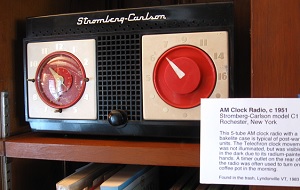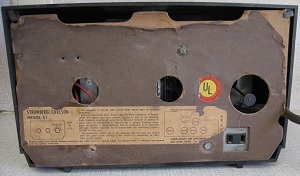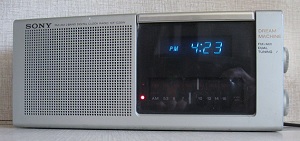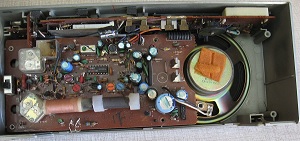Stromberg Carlson and Sony clock radios | Telos Alliance
By The Telos Alliance Team on Mar 25, 2015 4:45:00 PM
 Stromberg Carlson and Sony clock radios
Stromberg Carlson and Sony clock radios
This installment of Found in the Attic is a twofer. It features a genre of consumer electronics that is rapidly disappearing from the store shelves: the clock radio. As millennials enter the consumer market in larger numbers, sales of clock radios decline. Why? They use the alarm function built into their smartphones, and have no need or interest in purchasing an additional item.Today's subjects recall the glory days of the clock radio. The Stromberg Carlson model C1 dates from 1951, while the Sony ICF-C20W Dream Machine was manufactured in 1981.
The C1is typical of post-war AM radios. It has a bakelite case, and the circuit is a classic 'All American Five'. The clock movement was made by Telechron, a big name in electric clocks back in the day. It features a 'Slumber Switch', adjustable for up to 60 minutes of additional sleep, something not found in later digital alarm clocks. There is no need for an illuminated clock face; the radium-painted hands and numerals glow in the dark just fine.
Another feature of clock radios from this era is the switched AC outlet on the back. It was relay-controlled, and came on with the alarm. Contacts are rated for 1100 watts, and the AC cord is heavy duty to handle the extra current.
What was its purpose? While the outlet could b e used for anything, the intent was to have your clock radio in the kitchen with the coffee pot plugged into the back. Put in the grinds and water before you go to bed, and set the clock's alarm to on. By the time you emerge from the shower in the morning and come down to the kitchen for breakfast, your coffee is already brewed, and your favorite AM top-40 radio station is playing. How cool is that?
e used for anything, the intent was to have your clock radio in the kitchen with the coffee pot plugged into the back. Put in the grinds and water before you go to bed, and set the clock's alarm to on. By the time you emerge from the shower in the morning and come down to the kitchen for breakfast, your coffee is already brewed, and your favorite AM top-40 radio station is playing. How cool is that?
From the Stromberg Carlson clock radio, we fast forward 30 years to the post-disco era of 1981, and the Sony ICF-C20W. Consumer electronics have changed a great deal. The Sony is a lot smaller, thanks to printed circuit boards, transistors and integrated circuits. The time is now displayed on a blue fluorescent digital display, and there is a 9-volt battery to maintain the time during power glitches. The radio is AM-FM, and the switched AC outlet has disappeared. Contemporary automatic drip coffee makers usually have built-in clock timers to start themselves in the morning.
Many would be surprised to learn that the world's first digital clock radio came out in1968. The Sony 8FC-59, nicknamed the 'Digital 24', had a horizontal format for bedside use. Models were available in black, white and red. Fluorescent displays had not yet been invented, and the display on the 8FC-59 was comprised of individual panels with printed digits that flip over to show the time. Users could be awakened by an AM-FM radio or buzzer.
 With a robust economy during the 1970s, the consumer electronics market took off, and competition was fierce. Sony gained a bigger footprint in the clock radio market with a clever bit of marketing strategy. Sony did not sell clock radios with snooze buttons. Instead, they sold 'Dream Machines' with 'Dream Bars'. And really, who would want to buy a clock radio, when you could own a Dream Machine?
With a robust economy during the 1970s, the consumer electronics market took off, and competition was fierce. Sony gained a bigger footprint in the clock radio market with a clever bit of marketing strategy. Sony did not sell clock radios with snooze buttons. Instead, they sold 'Dream Machines' with 'Dream Bars'. And really, who would want to buy a clock radio, when you could own a Dream Machine?
The product line began in the 1970s and featured countless innovative designs, one of the most memorable being the 'Digicube' series of clock radios. After about a 40-year run, the line was discontinued 5 years ago. Sony still sells clock radios, just not Dream Machines. One of the last Dream Machines took clock radios into the Internet age. Released in 2009, the Sony ICF-CL75iP Dream Machine included an iPod dock and digital picture frame. List price was $180.00.
But perhaps the award for cleverest bit of technology in the ‘80s clock radio market should go to Panasonic. One of their models could project the clock's digital time display onto the wall or ceiling, making it easy to check the time in the middle of the night without fumbling around for your glasses. This projection feature is still offered on some clock radios. The next time that you're in a thrift store and see a nice clock radio – grab it. They just may be going the way of 8-track players.
Both of these clock radios were found in the trash, and both are in working condition. The Stromberg  Carlson is missing the knobs from the clock, but, there is a box of those knobs somewhere in the attic.
Carlson is missing the knobs from the clock, but, there is a box of those knobs somewhere in the attic.
The sound quality of the Sony leaves a bit to be desired, but that problem should go away when the 35-year-old electrolytic capacitors are replaced. The tiny incandescent bulb that illuminates the AM-FM radio dial has burned out and also awaits replacement.
These old appliances were recently given a thorough cleaning and are now on display – the Sony in a special exhibit of consumer electronics of the 1970s-80s.
Telos Alliance has led the audio industry’s innovation in Broadcast Audio, Digital Mixing & Mastering, Audio Processors & Compression, Broadcast Mixing Consoles, Audio Interfaces, AoIP & VoIP for over three decades. The Telos Alliance family of products include Telos® Systems, Omnia® Audio, Axia® Audio, Linear Acoustic®, 25-Seven® Systems, Minnetonka™ Audio and Jünger Audio. Covering all ranges of Audio Applications for Radio & Television from Telos Infinity IP Intercom Systems, Jünger Audio AIXpressor Audio Processor, Omnia 11 Radio Processors, Axia Networked Quasar Broadcast Mixing Consoles and Linear Acoustic AMS Audio Quality Loudness Monitoring and 25-Seven TVC-15 Watermark Analyzer & Monitor. Telos Alliance offers audio solutions for any and every Radio, Television, Live Events, Podcast & Live Streaming Studio With Telos Alliance “Broadcast Without Limits.”
Recent Posts
Subscribe
If you love broadcast audio, you'll love Telos Alliance's newsletter. Get it delivered to your inbox by subscribing below!